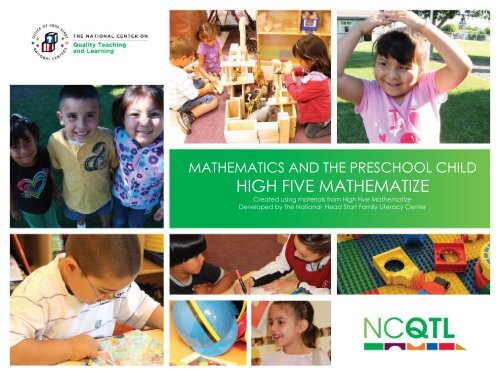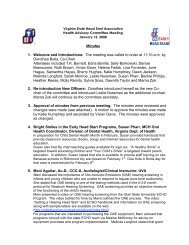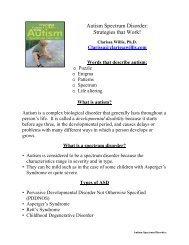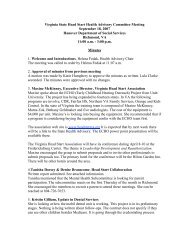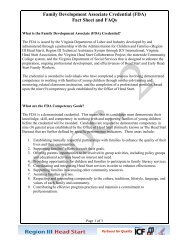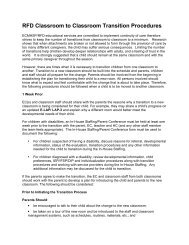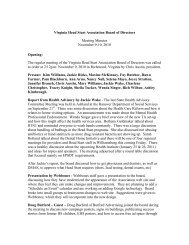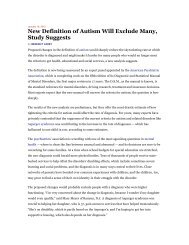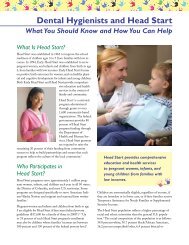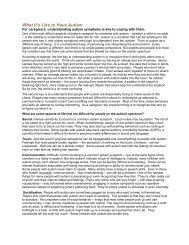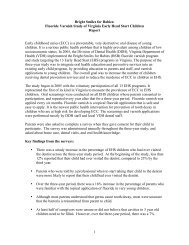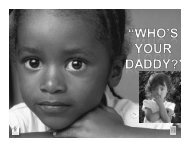Headstart's High Five Mathematize
Headstart's High Five Mathematize
Headstart's High Five Mathematize
You also want an ePaper? Increase the reach of your titles
YUMPU automatically turns print PDFs into web optimized ePapers that Google loves.
MATHEMATICS AND THE PRESCHOOL CHILD<br />
HIGH FIVE MATHEMATIZE<br />
Created using materials from <strong>High</strong> <strong>Five</strong> <strong>Mathematize</strong><br />
Developed by the National Head Start Family Literacy Center
MATH MATERIALS<br />
• Pick-up materials<br />
• Experiment with your materials<br />
• Make a construction and<br />
share one math concept about<br />
what you made
Own Comfort Level with Math<br />
MATH AND ME<br />
Comfort Level Teaching Preschool Math<br />
• Scatterplot
THE IMPORTANCE OF EARLY<br />
CHILDHOOD MATHEMATICS<br />
• There is a significant math gap at<br />
kindergarten entry for low income children<br />
(Denton & West, 2002).<br />
• Early math skills in kindergarten predicted 5 th<br />
grade achievement in math and AND<br />
reading (Claessens, Duncan & Engle,<br />
2006).
• Mathematical ideas are<br />
in children’s play and<br />
everyday experiences.<br />
• Young children develop<br />
some math concepts<br />
through self-guided<br />
discoveries.<br />
• Adult support is essential<br />
to maximize learning – to<br />
move mathematical<br />
development along.
MATHEMATIZE<br />
Definition: to bring out the math in what children are<br />
doing (commenting, questioning) Whee! Look how fast the<br />
• Example:<br />
ball rolls down the slide.<br />
You stayed up and the ball<br />
went down!<br />
Which slides down faster –<br />
a ball or a boy? Why does<br />
the ball go so fast?<br />
Math Connections<br />
� Shape (geometry)<br />
� Spatial concepts:<br />
up, down<br />
� Speed, comparing<br />
(measurement)
Adults mathematize children’s experiences when<br />
they:<br />
• emphasize math concepts<br />
and relations<br />
• use mathematical language<br />
• make comments, ask and<br />
answer questions, and pose<br />
math-related problems<br />
• provide a variety of<br />
materials and tools for<br />
exploration of math ideas
<strong>Mathematize</strong> Example:<br />
In Daddy’s Shoes<br />
Those shoes are so<br />
BIG and so LONG!<br />
They are much bigger<br />
than your little feet!<br />
How far can you walk<br />
in Daddy’s shoes?<br />
Math Connections<br />
• Size: big, little, long<br />
(measurement)<br />
• Comparing two objects:<br />
feet and shoes<br />
• Distance
MATHEMATIZE EXAMPLE:<br />
DISCOVERING SHADOWS<br />
How long is your shadow?<br />
Can you make it shorter<br />
or longer? Try to make<br />
your shadow as long as<br />
mine.<br />
Let’s take five steps back<br />
and see what happens to<br />
our shadows.<br />
Math Connections<br />
• Size, comparing:<br />
longer, shorter<br />
(measurement)<br />
• Number<br />
• Problem solving
MATHEMATIZE EXAMPLE:<br />
BUILDING WITH BLOCKS<br />
Tell me how you chose the<br />
blocks for your structure.<br />
I noticed that you used a<br />
long, flat block on the<br />
bottom.<br />
How did you make the two<br />
sides look the same?<br />
Math Connections<br />
• Sorting, matching<br />
• Shape, spatial<br />
relations (geometry)<br />
• Symmetry (patterns)
MATHEMATIZE EXAMPLE:<br />
SINGING WITH FRIENDS<br />
Listen to the pattern as I<br />
clap. Clap-clap, clap-clap.<br />
“<strong>Five</strong> little monkeys jumpin’<br />
on the bed!” What comes<br />
next?<br />
Oh, no! Another monkey fell<br />
off. How many are left?<br />
Math Connections<br />
• Repeating lyrics and<br />
movements, rhythms<br />
(patterns)<br />
• Number words<br />
• Counting backwards
• Numbers and<br />
Operations<br />
• Geometry & Spatial<br />
Sense<br />
• Patterns<br />
• Measurement<br />
MATH AREAS
NUMBERS AND OPERATIONS
COUNTING OBJECTS<br />
In preschool children’s<br />
counting skills improve<br />
when they…<br />
� Count small groups and<br />
label them with numbers<br />
� Compare groups of<br />
objects to determine<br />
which has more<br />
� Share evenly with friends
WHAT ARE CHILDREN LEARNING?<br />
• Subitizing<br />
– To look at a small<br />
group of objects<br />
and automatically<br />
know how many<br />
there are without<br />
counting<br />
• Cardinality<br />
– Knowing that the<br />
last number<br />
counted gives the<br />
total number of<br />
objects in the<br />
group. Answers the<br />
question of “how<br />
many?”
WHAT ARE CHILDREN LEARNING?<br />
• One-to-One<br />
Correspondence<br />
– Matching one and<br />
only one number<br />
word to each<br />
object<br />
• Combining and<br />
Separating<br />
– Refers to adding,<br />
subtracting, multiplying<br />
or dividing objects<br />
Examples:<br />
– “How many would you<br />
have if I gave you one<br />
more?”<br />
– “I have three graham<br />
crackers but if I eat<br />
one, how many will I<br />
have left?”
PRESCHOOL COUNTING<br />
• Watch the video<br />
• Identify what<br />
counting skill(s) the<br />
child understands<br />
• Determine which<br />
skills a teacher<br />
could help the child<br />
learn next
REPRESENTING NUMBER<br />
Help children<br />
learn to connect:<br />
– Concrete<br />
Objects<br />
– Spoken Words<br />
– Symbols, like<br />
dots or tally<br />
marks<br />
– Written<br />
numerals<br />
3<br />
• Written<br />
Numerals<br />
* * *<br />
• Concrete<br />
Objects<br />
“Three”<br />
• Spoken<br />
Number<br />
Words
DEVELOPING NUMBER AND<br />
OPERATION CONCEPTS<br />
• Provide engaging materials for children to count and compare<br />
• Engage children in finger plays that involve counting<br />
• Model counting and take advantage of times to count throughout the<br />
day<br />
• Use the question “how many” to encourage children to count, compare,<br />
and talk about quantity<br />
• Model and teach counting strategies, such as touching objects, lining up<br />
objects, pulling each object to the side after it is counted<br />
• Pose problems involving number, for example, “How many counting<br />
bears are in your cup?” and “If you give me one, how many will you<br />
have?”<br />
• Encourage children to write numbers that are meaningful, such as their<br />
age, how many siblings they have, how many days until grandma visits<br />
• Provide materials to play games, such as cards, dominos, dice, and<br />
books
LEARNING ACTIVITY TIME<br />
NOW IT’S YOUR TURN!<br />
• With a partner create a preschool math<br />
counting game using your materials<br />
• Determine the rules for your game<br />
• Identify which counting skills it teaches<br />
• Play your game!
GEOMETRY AND SPATIAL SENSE<br />
During the preschool<br />
years, children learn to…<br />
– Name common 2-D and<br />
3-D shapes<br />
– Identify shapes by their<br />
attributes<br />
– Develop spatial sense<br />
• Building with blocks<br />
• Working puzzles<br />
• Climbing<br />
• Playing ball with a friend
points<br />
lines<br />
angles<br />
surfaces<br />
solids<br />
GEOMETRY IS ABOUT . . .
WHAT ARE CHILDREN LEARNING?<br />
�Recognizing and Naming Shapes<br />
�Two-Dimensional Shapes<br />
� Have height and width, but no depth<br />
�Three-Dimensional Shapes<br />
� Have height, width, and depth<br />
� Have faces, edges, and corners (or vertices)
WHAT ARE CHILDREN LEARNING?<br />
• Geometric and Shape Attributes<br />
– Length of sides<br />
– Number of sides<br />
– Size of angles<br />
– Number of angles<br />
– Two versus three dimensions<br />
– Curved or straight lines<br />
– Diameter, radius and circumference for<br />
curvilinear shapes, like circles or spheres
FINDING RECTANGLES AND CIRCLES<br />
• Watch the video<br />
• What geometry<br />
concepts are<br />
illustrated in this<br />
video?<br />
• How does the teacher<br />
intentionally focus the<br />
children on<br />
geometry?
Learning Activity<br />
Get ready for a hands-on experience making<br />
shapes with Wooden Pattern Blocks!
MAKE SHAPES BY PUTTING TWO OR<br />
MORE PIECES TOGETHER.<br />
• Use your wooden pattern blocks to compose new<br />
shapes.<br />
– Put the shapes together in different combinations by<br />
sliding, rotating (turning), or flipping them. Take them<br />
apart and start again.<br />
• Challenge yourself!<br />
– See how many different shapes you can make using just<br />
one shape.<br />
– Try to make at least 5 different rectangles using a<br />
combination of similar and different shapes.
Slide! Rotate!<br />
Young children learn to manipulate<br />
shapes using these transformations, too!<br />
You can observe this when you watch<br />
them match shapes in a shape sorter,<br />
work puzzles, and create designs,<br />
patterns, and constructions with blocks or<br />
2-D shapes.<br />
Flip!
DEVELOPING GEOMETRY AND SPATIAL SENSE<br />
CONCEPTS<br />
• Help children notice attributes of shapes such as number of<br />
sides and corners, curved versus straight lines, etc.<br />
• Provide examples of 2-D shapes that are irregular or in<br />
different orientations so children can expand their thinking<br />
about shapes<br />
• Provide opportunities to put together and take apart<br />
different shapes<br />
• Plan experiences that encourage children to move their<br />
bodies through space in a variety of ways (obstacle<br />
courses, acting like different animals, “Going on A Bear<br />
Hunt, etc.)<br />
• Talk with children about:<br />
– Similarities and differences between 2-D and 3-D shapes<br />
– How to figure out where a puzzle piece fits<br />
– What they are doing and where things are using descriptive<br />
language
PATTERNS<br />
• Preschoolers need<br />
opportunities to engage<br />
in a variety of<br />
experiences with pattern<br />
(music, movement, art,<br />
stories, blocks).<br />
• Through these<br />
experiences, they learn<br />
to recognize and<br />
reproduce patterns that<br />
they hear or see and<br />
even create their own<br />
patterns.
WHAT IS A PATTERN?<br />
A pattern is a regular and<br />
predictable arrangement of things.<br />
– Regular means that the arrangement<br />
occurs in a consistent way—in a<br />
repeating or growing manner.<br />
– Predictable means that after the pattern<br />
is established, you can figure out what<br />
comes next.
WHAT CAN MAKE A PATTERN?<br />
Many things can make a<br />
pattern:<br />
– Objects<br />
– Actions<br />
– Sounds<br />
– Images<br />
– Numbers<br />
– Events<br />
Patterns are everywhere!
REPEATING PATTERNS<br />
• Watch the video<br />
• Identify different ways<br />
in which children are<br />
engaged with<br />
patterns<br />
• List other engaging<br />
ways to teach<br />
patterning
REPEATING PATTERNS<br />
Repeating patterns replicate a certain sequence<br />
(core unit) again and again.<br />
This girl made an ABBABB<br />
pattern. The repeating sequence<br />
is “blue ring, red ring, red ring.”
GROWING PATTERNS<br />
Growing patterns change from one value to another<br />
in a predictable way. This often involves a change in<br />
number, as in the patterns pictured below.<br />
This boy made a type of<br />
growing pattern by<br />
arranging sand dollars in<br />
order of size.<br />
Seriation<br />
a type of classifying<br />
and patterning,<br />
requires objects to be<br />
arranged in an<br />
increasing or<br />
decreasing order
– Recognize<br />
– Copy<br />
– Describe<br />
– Create<br />
– Extend<br />
PATTERNING SKILLS<br />
Children learn about patterns by working<br />
with them. Through a multitude of<br />
experiences they learn to do the<br />
following with patterns:<br />
B I N G O<br />
I N G O<br />
N G O<br />
G O<br />
O
DEVELOPING PATTERN CONCEPTS<br />
• Provide opportunities for children to sort or arrange<br />
items like lids, buttons, or toy animals by an attribute,<br />
such as color of lids, number of holes in buttons,<br />
where animals live<br />
• Create patterns with children and encourage them<br />
to make and describe their own patterns<br />
• Plan for patterning not only with physical objects,<br />
but choose songs, stories, and games that involve<br />
patterns<br />
• Talk about the regular, predictable parts of the<br />
school day and ask what comes next<br />
• Represent movement, object, or sound patterns with<br />
pictures or symbols
PATTERNING: ACTIVITY TIME<br />
• Create a pattern using the<br />
materials at your table<br />
• Once complete explain<br />
your pattern another<br />
person at your table,<br />
include what type of<br />
pattern it is and how you<br />
created it<br />
• Write down and share<br />
ways you are going to<br />
incorporate more patterns<br />
into your classroom
MEASUREMENT
Young children’s understanding of measurement is<br />
grounded in their real-life experiences.<br />
• A child plays with rocks in the science center and<br />
says, “This rock is so heavy!”<br />
• Children in the dramatic play area discuss family<br />
roles based on size, “You are the baby because<br />
you’re smaller. I’m the mommy because I’m<br />
bigger.”<br />
• During lunch time, children talk about differences<br />
in amounts of food on their plates and how much<br />
milk they have.
WHAT CHILDREN ARE LEARNING<br />
• Length, Height, Width, and Area<br />
– Enjoy measuring distances and area<br />
using non-standard measurement tools,<br />
such as lengths of string, links, own<br />
hands.<br />
– Benefit from opportunities to explore<br />
standard measurement tools, such as<br />
measuring tapes, rulers, and scales.<br />
– Lots of practice and experimentation!!
WHAT CHILDREN ARE LEARNING<br />
• Weight<br />
– Intrigued by the differences in<br />
weights of objects that are similar in<br />
size.<br />
– Plan experiences that allow children<br />
to make comparisons.<br />
– Provide opportunities for exploration<br />
• Example: A balance scale and many<br />
objects of different weights
WHAT CHILDREN ARE LEARNING<br />
• Volume and Capacity<br />
– Children often experience<br />
volume and capacity in their<br />
play.<br />
– Capacity- how much a<br />
container can hold<br />
– Volume- the space that a<br />
solid object or liquid takes up
WHAT CHILDREN ARE LEARNING<br />
• Time<br />
– Children think of time in terms of their own<br />
experiences<br />
– Time is an abstract idea for preschool<br />
children<br />
– Explain time in a meaningful manner<br />
• Example:<br />
– Child-friendly daily schedule<br />
– Consistent transitions (2 min warnings)<br />
– Discuss past and future events, “when I was a<br />
baby”, “when I grow up”<br />
– Talk about yesterday, tomorrow, and next week
ELEPHANT FEET: HOW TALL AM I?<br />
� Watch the video<br />
� Identify what<br />
measuring skills<br />
children are learning<br />
� Brainstorm ways to<br />
extend this activity<br />
to integrate other<br />
measurement<br />
concepts
DEVELOPING MEASUREMENT<br />
CONCEPTS<br />
• Provide materials that encourage children to<br />
explore measurement, like standardized and<br />
non-standardized tools<br />
• Use language that compares quantities (more<br />
than, less than, same as, etc.)<br />
• Use measurement terminology to identify<br />
differences in attributes (longer, shortest,<br />
heavier, lightest, etc.)<br />
• Suggest measurement strategies when<br />
children compare size, capacity, weight, and<br />
other dimensions
LEARNING ACTIVITY: MEASUREMENT<br />
• Find a partner<br />
• Select two materials<br />
from your table<br />
• Using one material at a<br />
time measure the<br />
length of each of your<br />
shoes, then repeat with<br />
another material<br />
• Record your data<br />
• Discuss the your<br />
learning process as you<br />
completed this activity
HOW DO CHILDREN LEARN MATH?<br />
• Children learn math skills naturally through<br />
everyday experiences and through planned<br />
activities.<br />
• Teachers must MATHEMATIZE to help<br />
children connect these everyday math<br />
experiences.
A FINAL NOTE . . .<br />
• Young children need a multitude of experiences<br />
to develop an understanding of math concepts.<br />
• Provide a variety of experiences to support<br />
different learning styles.<br />
• Start with simple skills and slowly work toward<br />
more complex ones.<br />
• Be patient; children will make many errors when<br />
learning these concepts, but with experience they<br />
will learn and benefit from this knowledge.
MATH MATRIX<br />
• Use this form to plan math activities around<br />
the daily schedule.<br />
• Write down specific materials, activities, and<br />
conversations that will help you intentionally<br />
teach across these four math areas.


